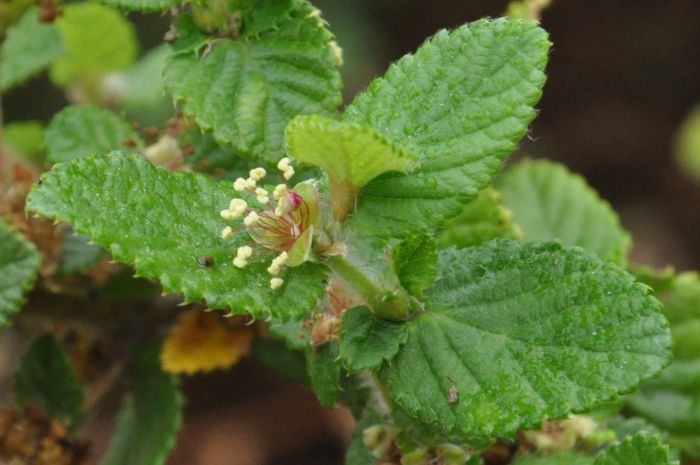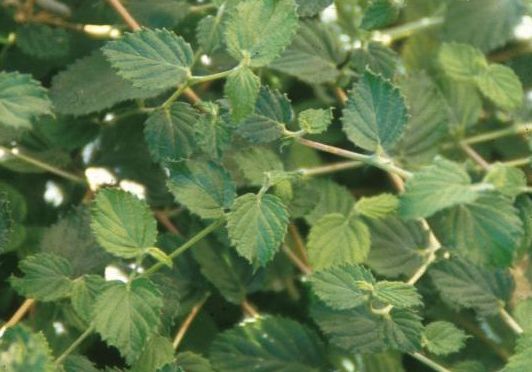Cliffortia odorata
Cliffortia odorata L.f.
Family: Rosaceae
Common names: wild vine (Eng.); wildewingerd, wildevyerank (Afr.)
Introduction
A hardy evergreen groundcover, with attractive, oval, green leaves, spreading vigorously in full sun or part shade.

Description
Description
Cliffortia odorata is a scrambling shrub that produces many vine-like stems, up to 1 m long and forms dense thickets in sheltered places. The young stems are hairy and slightly pink, but later become hairless and rust-brown. The leaves are alternate, simple, toothed, non-spiny, dark to yellow green, leathery and hairy only on the lower surface. When rubbed, the leaf is aromatic. The leaf surface is covered in straight, parallel lateral veins that are closely spaced and emerge at an angle from the midrib. These veins are conspicuously indented on the upper surface and run straight into the margins.

This shrub has unisexual flowers, either on separate plants or on the same plant, very rarely with bisexual flowers. These flowers are small and inconspicuous, borne in the leaf axils. The plant flowers throughout the year, except in autumn (May to February). The fruit is dry and enclosed in the hardened calyx.

Conservation Status
Status
Cliffortia odorata is not threatened, and is assessed as one of the Least Concern (LC) species in South Africa at present.
Distribution and habitat
Distribution description
The wildewingerd is widespread on damp mountain slopes of the Western Cape, the Eastern Cape and KwaZulu-Natal, in places where moisture is readily available and often beside rivers.

Derivation of name and historical aspects
History
This genus is named in honour of George Clifford (1865–1760), who was a rich Anglo-Dutch financier and also a director of the Dutch-East India Company. Clifford was a keen horticulturist and owned a famous garden and zoo in Amsterdam. The species name odorata means ‘scented’, referring to the aromatic leaves.
Cliffortia is a genus of ± 120 species that belongs in the Rosaceae, a large family, comprising of 120 genera with ± 3 000 species worldwide and includes many well-known plants, such as apples, plums, prunes (Prunus), pears (Pyrus), and strawberries (Fragaria). This family also includes one of the most popular ornamental plants in the world, namely roses (Rosa).
The rose family is not well represented in southern Africa, with only 9 genera and about 150 species, with many of them being common and occupying a variety of habitats. Other noteworthy southern African members are C. ferruginea (glossy cliffortia or glastee), C. ruscifolia (climber’s friend or steekbos), Prunus africana (African almond) and Leucosidea sericea (oldwood).

Ecology
Ecology
Flowers are wind pollinated and are unisexual (male or female), which means that stamens (male) and ovaries (female), do not occur in the same flower.
Uses
Use
The leaves of Cliffortia odorata have a variety of medicinal uses in traditional medicine and some of its properties are now recognized in modern pharmacology. The leaves are used to treat cattle, goats and dogs, and as a lotion to wash wounds, infected sores, bites, blisters and to soothe haemorrhoids. It is also taken orally to treat mouth and throat infections, diphtheria, colds, flu, headaches, sore throats, sinus, chills, fevers, painful menstruation and threatened miscarriages.
Because of its long and flexible but strong stems, and dense and clustered form, Cliffortia odorata was harvested and used to build huts in the old days, particularly the dome-shaped, mat-covered huts of the KhoiKhoi people.

Growing Cliffortia odorata
Grow
Cliffortia odorata can be grown in full sun or semi-shade, although it forms a tighter shrub in full sun. It is also very attractive when allowed to scramble over a slope or retaining walls. It is a useful filler in a shrubbery or mixed border.
In the garden, Cliffortia odorata is very easy to care for, adapting to most soils, surviving on little additional water once established and spreading vigorously. The basic requirements are full sun and well-drained soil. It is good in fynbos gardens as it is hardy and water-wise.
This plant can be propagated from cuttings taken in spring and autumn, which root easily within 2 to 3 weeks, or by removing rooted runners. The young plants react very well to feeding, and pinching the tips of the young stems encourages bushy growth.
References
- Goldblatt, P. & Manning, J. 2000. Cape Plants. A conspectus of the Cape flora of South Africa. Strelitzia 9. National Botanical Institute, Pretoria & Missouri Botanical Garden, Missouri.
- Jackson, W.P.U. 1977. Wild flowers of Table Mountain. Howard Timmins, Cape Town.
- Jackson, W.P. 1980. Wild flowers of the Fairest Cape. Howard Timmins (Pty) Ltd. Cape Town.
- Operation wildflower: accessed 21 January 2019. https://www.operationwildflower.org.za/index.php/component/joomgallery/climbers/cliffortia-odorata-wildewingerd-il-1721
- Powrie, F. 1998. Grow South African Plants. A gardener's companion to indigenous plants. National Botanical Institute, Cape Town.
- Roberts, M. 1990. Indigenous healing plants. Southern Book Publishers, Halfway House, Johannesburg.
- Trinder-Smith, T.H. 2003. The Levyns Guide to the plant genera of the south western Cape. Bolus Herbarium, UCT, Red Roof Design CC, Cape Town
- Viljoen, C. 2005. Cliffortia ferruginea L.f. (Rosaceae). PlantZAfrica. Internet. http://pza.sanbi.org/Cliffortia-ferruginea
Credits
Thembakazi Dyariwe
Kirstenbosch National Botanical Garden
April 2018
Plant Attributes:
Plant Type: Ground Cover, Shrub
SA Distribution: Eastern Cape, KwaZulu-Natal, Western Cape
Soil type: Sandy, Loam
Flowering season: Spring, Early Summer, Late Summer, Winter
PH: Acid, Neutral
Flower colour: Green, Red
Aspect: Full Sun, Morning Sun (Semi Shade), Afternoon Sun (Semi Shade)
Gardening skill: Easy
Special Features:
Horticultural zones








Rate this article
Article well written and informative
Rate this plant
Is this an interesting plant?
Login to add your Comment
Back to topNot registered yet? Click here to register.